Are you having a hard time getting in control of your home studio? Now might be the right time to invest in soundproof panels to ensure you get the best soundproofing experience.
You’ll be surprised how they can effectively minimize echo and vibrations from the entire room.
But wait, merely picking acoustic panels without the best quality will defeat its purpose of bringing better sound quality.
Don’t worry about having difficulty choosing because I’ll help you! Here are my top picks for the best acoustic foam panels!
Best Acoustic Panels
To give you a quick idea about acoustic foam panels, they are chunks of foam to attach to your walls and ceiling for sound dampening and eliminating unwanted sound reflections.
These sound-absorbing panels are best used at your theater and recording studios with full-blast music volume.
It can block sound that breaks out from the room. The materials used for these acoustic foam tiles will also reduce the outside noise from getting in.
They are not limited to being used in home studios but are also suitable in offices, conference rooms, restaurants, and even open spaces.
So, let’s head straight to my top picks, plus the complete buying guide.
1. ATS Acoustic Panels – Best Overall
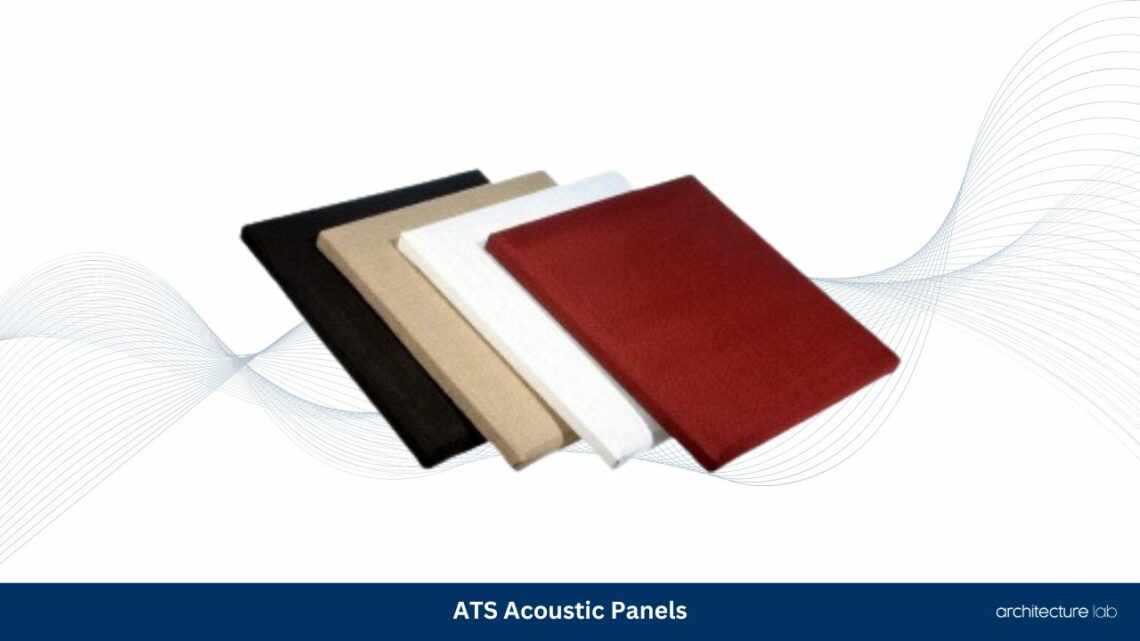
What We Like
- It has a wooden frame with insulation
- Eliminate reverberation and flutter echoes
- It has four color options
What We Don’t Like
- It was a bit expensive
- Tough to install
First on the list of the best acoustic foam panels is the ATS Acoustic Panels, with an excellent 1.0 NRC rating.
This means it is 100% efficient in sound dampening and reducing reverberation. These 2-inch thicker sound absorption tiles are accessible in four different colors.
Try using the black-colored acoustic tiles, as they seem to consume sound and light, which aids in decreasing reflection from big screens and monitors.
The acoustic panel comprises a wooden frame with insulation material and a jute fabric covering. They are made to last and are quite better than the egg crate design acoustic panels.
You can be extra artistic, as these acoustic panels can act as canvases, too, so you can paint and design them, whichever you fancy.
A bit more expensive than other brands of acoustic tiles, but if you want a premium acoustic panel with strong sound absorption, invest in more effective and long-term panels.
Depending on the size and thickness, you can purchase these acoustic panels, but they go from $40 to $88. You can visit their site at atsacoustics.com and take your pick.
2. Bubos Art Acoustic Panels – Best in Artistic Design
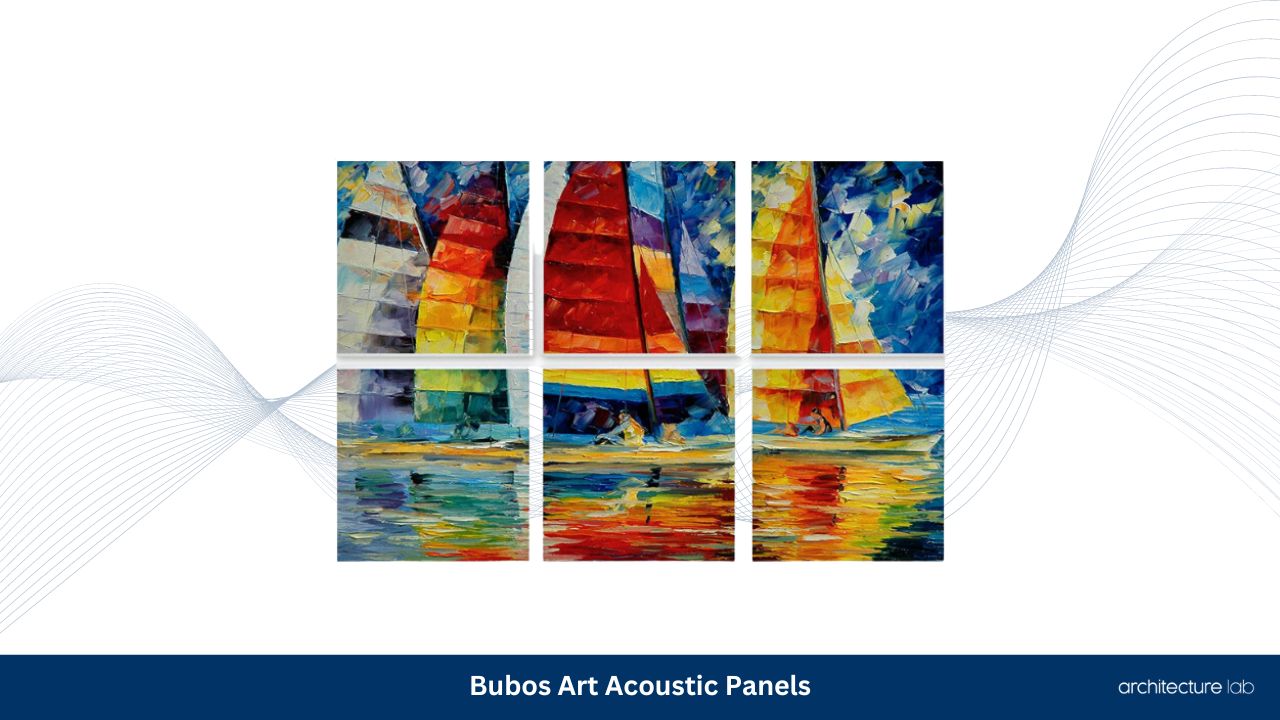
What We Like
- Stylish design doubles
- Easy installation
What We Don’t Like
- Pricey
If you have a great ear for music and, at the same time, some fresh eyes for art, then the Bubos Art Acoustic Panels might be the one you’re looking for.
It can transform the room into a music studio and is made to look like pieces of wall art that blend into your decor seamlessly.
All the while doing its job of dampening undesired sound reflection and background noise. They feature an NRC rating of 9.0, so they can mostly absorb 90% of the sound.
It has a dimension of 48 inches tall by 12 inches wide.
Its six-pack bundle should be adequate for most areas, such as living rooms and home theaters, considering that you don’t require wall-to-wall coverage.
You can purchase these art acoustic panels at Walmart for $155, but with a size of 72″ x 48″. You can also choose a different design from dancing stars, infinite loop, and racing sail.
3. Auralex Acoustics Studiofoam Wedgies – Best for Recording Studios
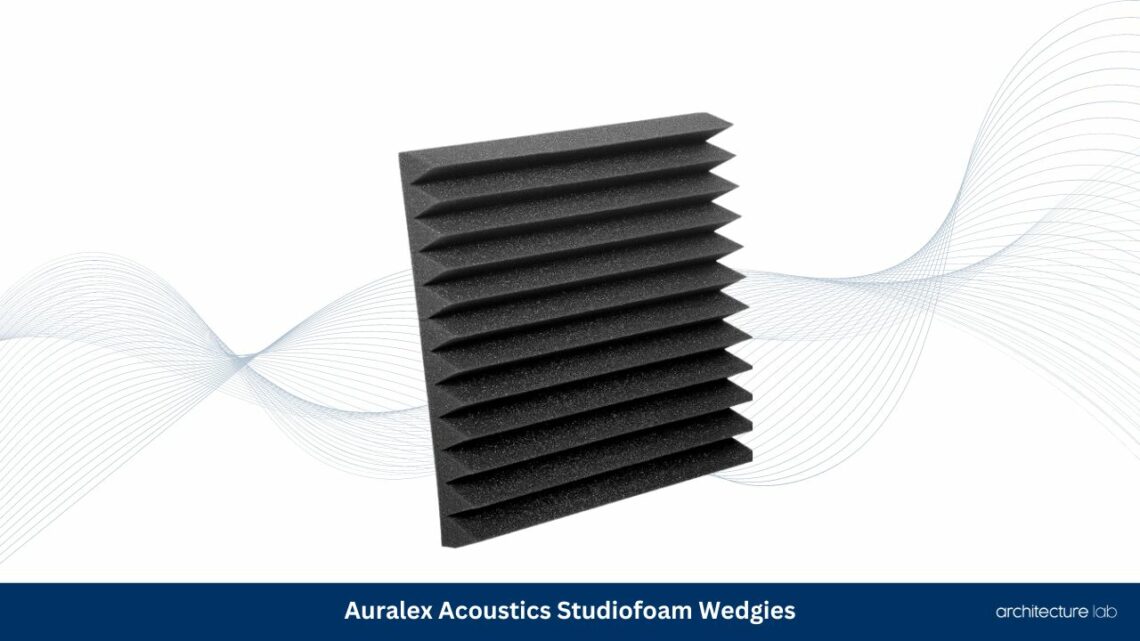
What We Like
- Lightweight
- It can be installed on any surface, and it’s fire-resistant
- It can be used together with bass traps
What We Don’t Like
- Limited charcoal gray color option
If you are building a home recording studio, you may choose one of the most reputable brands in sound treatment solutions, the Auralex Acoustics Studiofoam Wedgies.
They have an NRC rating of 0.8 and are excellent sound-dampening panels, especially for loud music. They also provide sound quality for subdued activities such as singing and podcasts.
One thing I like about the Auralex Studiofoam Wedgies is its reduced size. Each package has 24 pieces of 12-by-12-inch panels, enough to cover 24 square feet of space.
So it’s suitable for tight and reduced areas that need sound treatment.
If you want to optimize the acoustic treatment, you can use it with the bass trap, diffusers, and a spot-treating sound.
It will give an efficient sound-absorbing performance and supervise standing waves and flutter echoes.
Great value for its price, which you can buy for $154.99 at Auralex.com.
4. Clearsonic S2233 SORBER Panels – Best in Specs
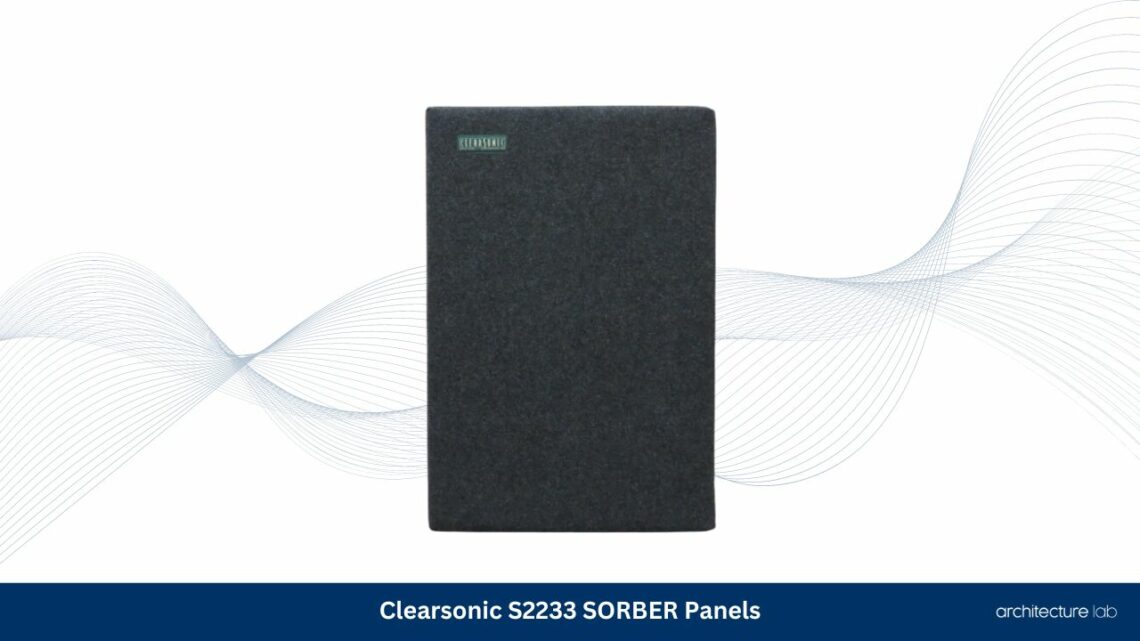
What We Like
- Super safe Cass A-fire rating
- Enclosed with heavy-duty carpet-type material
- Receptive to hoop and loop fasteners
What We Don’t Like
- A bit pricey
Another premium sound-absorbing panel is the Clearsonic S2233 SORBER Panel. It has an overall noise reduction rating greater than 90%.
It is 1.6-inch acoustic tiles that tend to exceed the standard 1-inch panels by at least 50%.
They can absorb lower frequencies and feature a compressed fiberglass core covered in a sturdy Velcro-receptive charcoal gray cloth.
The 22-inch wide and 33-inch high sound-dampening panels can be fastened to a ClearSonic Acrylic Shield for wall and ceiling sound treatment.
You can purchase this one at Clearsonic.com for $81.77.
5. Pro Studio Acoustics Wedge Foams – Best Value
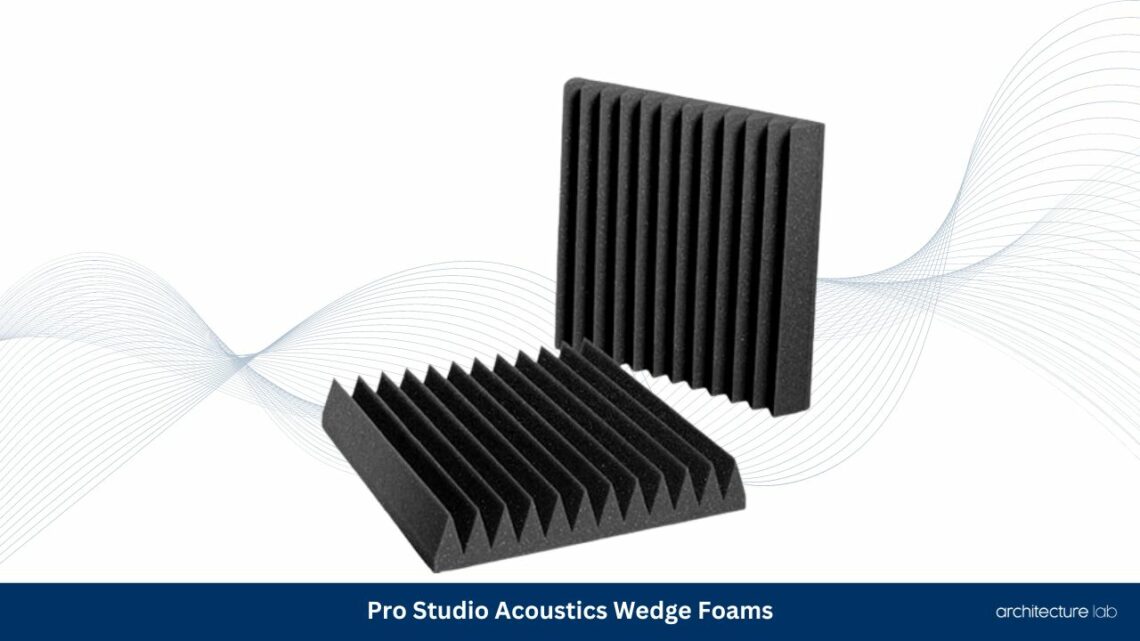
What We Like
- Cheaper
- They come uncompressed in a box
- Can cover a full wall or for spot treatments
- Thick design
What We Don’t Like
- Chemical smell
- Not uniform size and color
The Pro Studio Acoustic Wedge Foams will give justice to your money.
You can get these thick acoustic treatment panels as many as you want for your recording studios, control rooms, and home theaters without emptying your wallet.
They are shipped uncompressed, so you won’t need to wait days for them to expand. They are already set to get mounted.
The Pro Studio Acoustics is a 2-inch thick premium wedge foam that comes in a 12-pack with six panels in blue and six panels in black, so you can try to mix and match the tiles.
They are the perfect solution for decreasing standing sound waves and flutter echoes in small to medium-sized rooms (the 12-pack can cover 12 square feet).
If you want some extra appealing look, you can place them in an alternate pattern of color and alignment. This will give you a checkerboard motif and add a more professional look.
You can get these acoustic panels for $69.99 at Amazon.
6. Primacoustic London 8 – Best in Materials
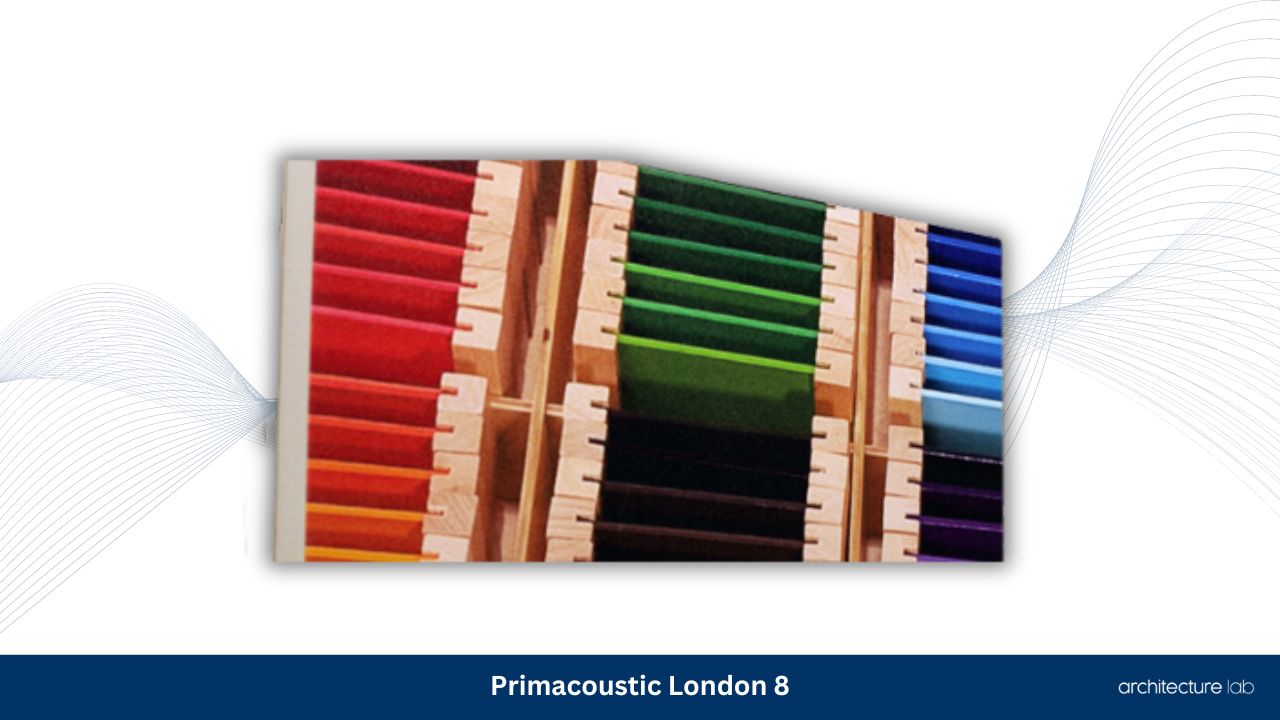
What We Like
- Class A fire-rated
- High-performance fabric
- Easy-to-use and install
What We Don’t Like
- Comes with a more expensive price tag
- Distinct smell
The Broadway London 8 is ideal for spaces with 100 sq. ft. (9.3 sq. m) dimensions, and you can incorporate them with other products, such as a bass trap for sound treatment in bigger spaces.
They’re a good option for starters who would want an acoustic treatment. The kits are easy-to-use, and they also provide respective mounting hardware and guides.
London 8 acoustic panels can flaunt their high density of 6lb per cubic foot fiberglass, giving off 5x greater sound absorption compared to the usual low-priced panels.
They made sure that even with fewer acoustic panels, you’ll still get sufficient and even absorption curves all around the low and high frequencies ranges.
They are often set up behind the listening area to help disperse flutter echo by absorbing sound vitality.
It addresses issues affecting the sound quality of any room, such as initial reflections and standing waves.
London 8 is available in room kit black and room kit gray for $371 at Amazon. The kits are also in a paintable finish.
7. Audimute – Best in Custom Solutions
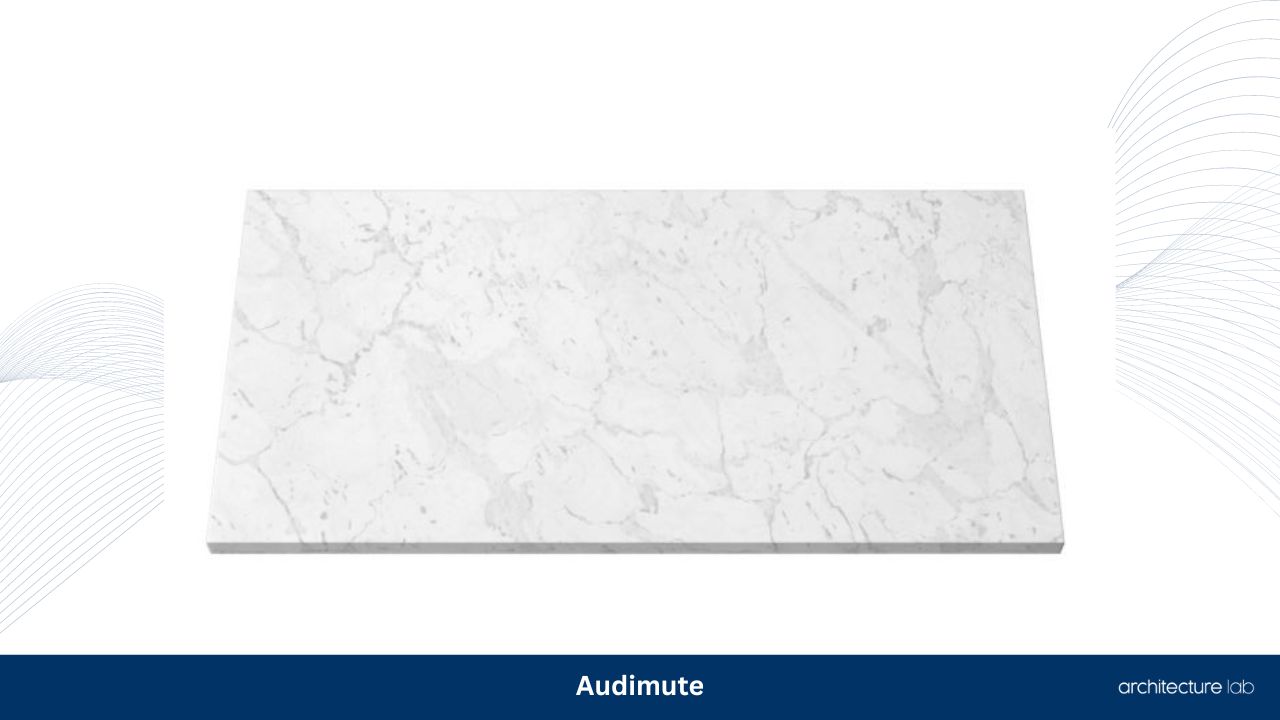
What We Like
- Consists mainly of recycled materials
- Free room analysis and custom solution
- Variety of products for your unique needs
What We Don’t Like
- Black Glue Line
The last of the best acoustic foam panels are the Audimute acoustic panels.
You can guarantee they are heavy duty, as they are made of eco-C-tex, Audimute’s recycled sound absorption material.
They efficiently reduce undesired sound reflection; they’re non-toxic and only need less energy to produce, unlike foam panels and traditional fiberglass products.
A great sound treatment with an NRC rating of 0.95. So, they can absorb an average of 95% of sound waves and background noise in contact with the sheet.
They are called the best in customized solutions, as they specialize in making sound treatments for all needs and settings.
The panels can be easily mounted using a construction-grade adhesive or the included hang tabs. Plus! They offer a generous return policy and ship the products faster.
You can also visit their site at Audimute.com and enjoy their 15% off acoustic panels holiday sale.
Buying Guide For The Best Soundproof Panels
Of course, you don’t go shopping and get what’s aesthetically pleasing.
You should get the best acoustic panels that will really improve the sound quality for control rooms and other spaces.
Learn the buying guide when picking out the best acoustic foam panels:
1. Acoustic Panel Noise Reduction Coefficient Rating
Look for the Acoustic Panel Noise Reduction Coefficient (NRC) on any brand you’ll find. It ranges between 0 and 1.
You will notice this rating as a decimal, which measures its efficiency in absorbing sound. The higher the rating, the more significant it is in sound absorption.
If you find a rating of 0.75, that indicates that 75% of the sound that will come across the acoustic foam panels will be consumed.
The closer the NRC rating is to 1, the better it is to absorb sound.
Since these acoustic foam panels do not completely remove the sound. Rather, they are absorbing it to keep you from hearing it.
If you find the thickest acoustic foam panels with a rating of 0.25, it would be pretty useless.
2. The SRC Metric
You can also check the Sound Absorption Coefficient (SRC) standard.
This metric will calculate absorption at a particular narrow band of frequencies.
It will perform well, especially for recording studios, as the NRC will only measure absorption at four frequencies (e.g., 2000 Hz, 1000 Hz, 500 Hz, 250 Hz).
The metric will help measure below 250 Hz, where the tricky frequencies in the home studio exist.
However, the SRC rating is only sometimes posted, unlike the NRC.
3. The Dimensions of Acoustic Panels
The standard acoustic foam panels come in 24″ x 24″ squares or 24″ x 48″ rectangles. These dimensions come in packages of 6, 12, and 24.
It makes a difference that installing acoustic panels will comprise the entire surface space of the home recording studio walls.
An excellent wall coverage differs depending on the room, but a good base for most recording studios is 48ft².
You can find bundles in combinations of 48 – 1ft² panels, 12 – 2ft² panels, and 6 – 2×4 ft panels.
For the normal size of any recording studio with a huge wall issue, you can use the more compact acoustic foam panels, as they are lighter and can be set up in the walls.
4. Surface Pattern
Acoustic foam panels usually have a flat surface or an engraved surface.
These carved panels are fashioned with raised marks like pyramids, ridges, egg crates, and acoustics wedge foam.
They are approximately two inches thick. Even so, they can be excellent soundproofing and sound absorbing due to their sculpted design.
The raised sculpted design will consume and reverse the sounds it bumps into.
So 2-inch thick acoustic tiles with sculpted design may be as productive as a 4-inch thick flat acoustic panel.
But this will also rely on how you install acoustic panels and the mid and high frequencies of the sound wave being absorbed.
5. Thickness of the Acoustic Panels
Acoustic foam panels have various shapes and dimensions, and it’s equally important to look for their thickness before buying one.
They usually come in one, two, and four inches thick; generally, the 4-inch thick acoustic panels are better at absorbing sound than the one-inch thick foam panels.
However, this does not signify that you always have to choose the 4-inch soundproof panels based on the surface pattern. The 2-inch acoustic panels with 3D patterns can also be efficient.
Besides, the 2″ foam panel is also considered the industry standard.
And if you’re doing things appropriately, the bass traps will already control and absorb bass frequencies.
Read more at Soundproofexpert.com.
What Are the Benefits of Soundproofing Panels?
The acoustic foam material or mineral wool will try to absorb the sound waves and provide reverberation control in enclosed rooms.
So when the sound waves hit the acoustic wedge foam tiles, they swiftly evaporate and eliminate the noise.
Here are the advantages of installing soundproofing panels:
1. Boost Sound Performance
The best soundproofing panels can improve sound quality at different locations.
It eliminates residual sound by dispersing sound waves from the first point of reflection.
It serves as an absorber and diffuser, which is essential in modifying the acoustic conditions of control rooms.
It enhances sound intelligibility at a variety of venues. Different locations have distinct conditions. Nevertheless, sound panels will help in properly confining the noise.
It absorbs unwanted sounds in areas with heavy foot traffic. Sound panels will simultaneously absorb sound for a peaceful environment.
Sound-absorbing panels are usually made from a timber frame consisting of layers of acoustic foam, which are suitable materials to absorb surface frequencies.
It will produce reverberation inside the hollow space, and above the hollow space is where the sound cancellation happens.
2. Easy to Install
You can easily install acoustic panels at your home studio and theater, even in offices and restaurants.
These acoustic foam tiles can be fastened using internal wall installation and sealing gaps, magnets, metal plates, adhesives, etc.
If you have tried mounting photos on your wall, you can set up acoustic foam panels with little effort.
But if you doubt your installation skills, you can also call local companies that offer installation services alongside the purchase and delivery of the sound panels.
Make use of some tips on how to soundproof a room cheaply.
3. Increased Comfort and Privacy
More than its improved sound quality, acoustic foam panels can comfort your ears and head, especially if you are a busy lad.
Activities and typical background noises in your home can make you feel annoyed, especially if too much noise is beating your ears.
But, by installing sound-dampening panels, you can remedy that concern.
This will also increase privacy, especially if you don’t want others to listen to your conversations.
Hard surfaces bounce sound all over the room, but acoustic foam panels will absorb it.
So echoes bear conversations, and deadening a space with better sound absorption can block sound from moving too far away.
How Many Acoustic Panels Do I Need in My Room?
Generally, you can start covering 15-25% of the wall surface area with sound-dampening panels.
But there are several factors that you need to consider, like the wall and ceiling surfaces, as they may need a distinct approach.
You don’t need 100% coverage, and you can have a better outcome with sound treatments offering 60% to 80% coverage.
You can also add acoustic clouds to the ceiling to intensify sound absorption when the wall space is restricted.
They can catch primary and secondary reflected sound when mounted with an interval between the ceiling and the cloud.
To complete soundproofing the room, you can even do soundproofing on hardwood floors or install soundproof insulation on tile floors.
Where Should I Place the Panels in the Room?
To begin installing acoustic panels in the control rooms, consider the room layout’s limitations.
If sound isolation solutions still need to be mounted, you will need to add soundproofing to the outside of the wall.
While for sound absorption, panels are usually set up on walls or hung from the ceiling.
1. Set up the panels in the first place on the wall where the sound wave hits before making it to the listeners’ ears.
2. Set up 3′ to 6′ up from the floor in spaces where much of the sound is generated by people standing in confined areas.
3. Put the panels and bass traps around corners and unusual spaces where the noise develops.
You can refer to this Audimute’s typical placements for optimum soundproofing effect.
Can You Use Egg Crates to Soundproof a Room?
Yes, you can, but it will not provide adequate soundproofing quality.
Egg cartons are cheaper, as they are made up of cardboard. They are similar to acoustic soundproofing foams but are not made to block sound effectively.
Egg cartons help decrease echoes and are pretty fair at deadening certain noises and frequencies.
However, there are better choices for insulating a studio from exterior noises than egg crates.
Are There Any Alternatives to Soundproofing Panels?
I cannot deny the fact that high-quality acoustic is quite pricey.
Though you can choose the cheaper ones on the side if you are on a tight budget, it would also be great to give you some alternatives to soundproofing panels.
1. Soundproofing Curtains
Soundproofing curtains are one of the most convenient ways to treat any room.
As the heavy drapes are made to absorb any sound that will be in contact with them.
Ideally, they are placed over the windows to obstruct the noise from reflecting your mixtape. You can also permanently install a curtain rod on the walls and place the curtain.
This will let you refine the amount of soundproofing you prefer, and you can easily modify the reverberation time.
They’re quite usual in professional places. Bands tend to use thick soundproof curtains for backstage rehearsals; if the studio is too big, the curtains can act as a divider.
Note that glass has an optimal resonance frequency of 400 Hz to consume any sound within that frequency.
2. Mineral Wool
Mineral wool is akin to fiberglass but much more compact. They are pricey but not as expensive as acoustic foam panels.
The solid material of mineral wool will need you to use a serrated edge knife. They are usually in rolled-up panels for easy transfer.
Mineral wool can effectively reduce noise and reverberation, but be cautious when using the exact amount, as removing all the reverb in the room will make the sound dry.
TIP: Start with the thinnest and smaller panels of mineral wool. A full-scale anechoic chamber will make mixing samples tougher due to the absence of any reverb.
3. Fiberglass
Fiberglass is a flexible material that comes in various shapes and forms.
You can utilize any fiberglass for soundproofing, but not the ones with reflective transparent sheets similar to glass.
They are super versatile and easy to work with. You can find pre-cut fiberglass acoustic panels that are cheaper than acoustic foam panels.
You can also opt for the standard fiberglass batt for insulation and divide it into functional pieces.
Plus! fiberglass will make the room warmer in the cold season.
Fiberglass is solid, so it will dampen the sound it comes in contact with. It would help if you placed fiberglass over the walls to consume the sound that would bounce off the wall.
Learn more alternatives at Homestudioexpert.com.
Conclusion
Acoustic foam panels have a two-way purpose.
You won’t be heard in the next room to keep the noise from breaking out even with the full volume at your recording studio.
Its echo-reducing effect can improve the sound quality in your studios by blocking sound reflections off the walls.
While tons of acoustic panels are available in the market today, make sure that you choose premium acoustic foam panels.
This will help you record with less room sound and will let you add your selected level of artificial room sound with the reverb effects.
Make sure you acquaint yourself with the buying guide, panel placements, and the application amount.


